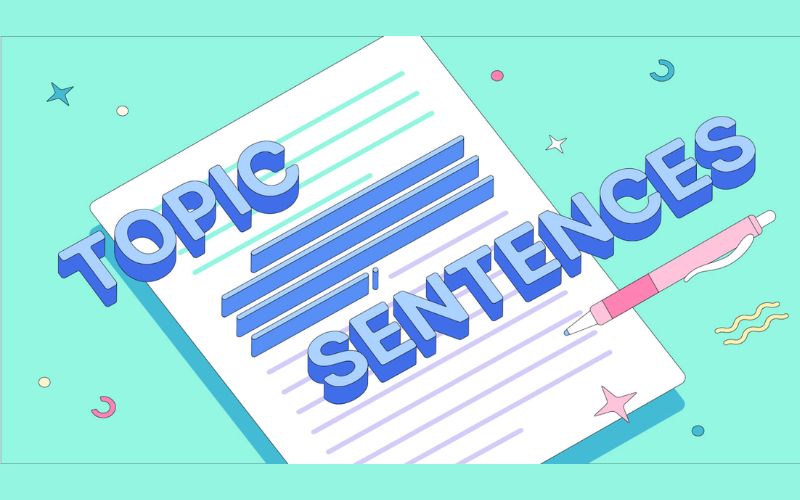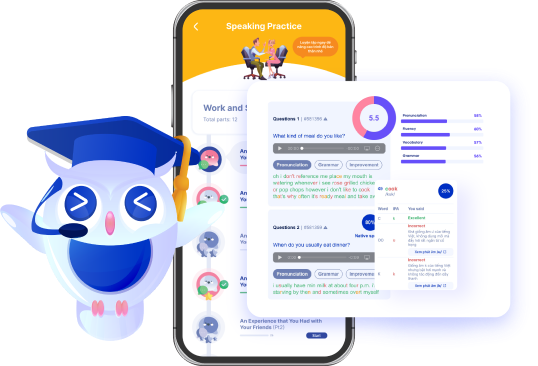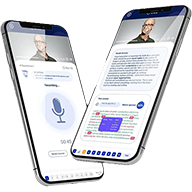IELTS Speaking Part 3 là phần cuối và cũng là khó nhất trong bài thi Speaking IELTS. Bài viết này sẽ giúp bạn hiểu rõ hơn về IELTS Speaking Part 3 là gì, tiêu chí chấm điểm, các chủ đề thường gặp và cách trả lời chi tiết nhất. Hãy cùng theo dõi với Edmicro nhé!
IELTS Speaking Part 3 là gì?
IELTS Speaking Part 3 là phần cuối cùng của bài thi nói IELTS, kéo dài từ 4 đến 5 phút. Trong phần này, bạn sẽ được giám khảo đặt các câu hỏi liên quan đến chủ đề đã được nêu ra ở Part 2. Nếu ở Part 2 bạn gặp topic “A time you were late”, rất có thể ở Part 3 bạn sẽ được hỏi về Punctuality (sự đúng giờ).
Tương tự như Speaking Part 1, bạn cũng sẽ hỏi đáp 1-1 cùng giám khảo. Tuy nhiên, những câu hỏi này sẽ phức tạp, trừu tượng, đòi hỏi khả năng phân tích và tư duy hơn. Ví dụ
Với topic: Travel
Part 1: How often do you travel?
Part 3: Do you think traveling can change the way people think?
Các dạng câu hỏi của IELTS Speaking Part 3
IELTS Speaking Part 3 thường có 6 dạng câu hỏi. Từ các dạng câu hỏi, bạn có thể đánh giá nên sử dụng thì gì, và giám khảo đang cần tìm hiểu cái gì. Ít trường hợp giám khảo sẽ hỏi toàn bộ cả 7 dạng này.
1. Opinion (Ý kiến)
Thí sinh sẽ được yêu cầu đưa ý kiến về một chủ đề, chủ điểm nào đó. Ví dụ:
Question: Do you think people in your country prefer sports more than they used to be?
Answer: Personally, I think people in Vietnam prefer sports more than they used to be. There are several reasons for this. First, in my view, people are more aware of the benefits of sports for their health, fitness, and well-being. Vietnamese also have more access to sports facilities, equipment, and information. They can easily find places to play sports, buy or rent sports gear, and learn new skills or techniques. Third, people have more exposure to sports media. They can watch or follow different kinds of sports on TV, online, or social media.

Bạn có thể sử dụng các cụm sau để đưa ra ý kiến:
- Personally, I think…
- In my opinion
- In my experience
- Speaking for myself…
- I believe that…
- In my view/From my point of view…
- If you ask me…
- I feel sure that…
Câu hỏi ý kiến (opinion) là câu hỏi trực diện nhất trong IELTS Speaking Part 3.
2. Hypothetical (giả thiết)
Đây là câu hỏi giả định về các tình huống tưởng tượng và không có thật. Để trả lời câu hỏi giả định, bạn cần sử dụng câu điều kiện. Bạn có thể tham khảo ví dụ sau:
Question: If you could play any sport professionally, what would it be and why?
Answer: If I could play any sport professionally, I would choose to play soccer. Soccer is a popular and exciting sport that requires skill, teamwork, and strategy. First off, I enjoy playing soccer as a hobby, and I admire the professional players who compete in the World Cup, the Champions League, and other tournaments. In addition, I would love to have the opportunity to play soccer at a high level, to represent my country or club, and to entertain the fans. I think playing soccer professionally would be a rewarding and fulfilling career for me.
3. Compare and Contrast (so sánh tương phản)
Thí sinh sẽ được yêu cầu so sánh để tìm lợi ích, bất lợi giữa 2 sự vật, sự việc. Ví dụ như:
Question: What is the difference between studying online and studying at a school?
Answer: Studying online allows for flexible, self-paced learning from anywhere, whereas studying at a school involves attending physical classes with fixed schedules. Online studying offers virtual interactions and independence, in contrast studying at a school provides face-to-face interactions, immediate guidance, and access to physical resources.
Khi gặp dạng bài so sánh, bạn nên sử dụng các từ sau:
Tương phản
- In contrast
- Whereas
- Conversely
- Nevertheless
- Otherwise
- On the other hand
So sánh
- In the same way
- Similarly
- Likewise
- Comparatively
- Compared with
Với dạng câu hỏi này, bạn có thể trả lời bằng cách áp dụng cấu trúc như sau: Khẳng định rằng giữa hai sự vật, sự việc có sự khác nhau – so sánh 1 – so sánh 2 – kết luận ngắn.
4. Change
Dạng câu hỏi thứ 4 của IELTS Speaking Part 3 dùng để so sánh sự thay đổi giữa quá khứ và hiện tại. Vì cần đan xen giữa quá khứ và thực tại nên thí sinh hãy lưu ý cách dùng thì của mình.
Question: How has art changed in your country over the past few decades?
Answer: Art in Vietnam has experienced significant transformations over the past few decades. It has shifted from traditional forms to more contemporary and experimental approaches. Artists now explore diverse mediums, address social and cultural issues, and participate in international events. Vietnamese art has become more vibrant, diverse, and globally recognized.
5. Future
Thí sinh sẽ nhận được câu hỏi để dự đoán tương lai. Đây cũng là một dạng câu hỏi ý kiến (opinion), tuy nhiên nó sẽ được sử dụng để đánh giá khả năng ngữ pháp. Ở đây cụ thể là sử dụng thành thạo thì tương lai. Ví dụ như:
Question: Will AI replace teachers in the future?
Answer: While AI has the potential to enhance teaching and learning experiences, it won’t be unlikely to fully replace teachers in the future. Teachers provide valuable human interaction, personalized guidance, and social-emotional support that AI cannot replicate. AI will assist teachers by automating certain tasks and providing data-driven insights, but the role of teachers in education will remain essential for effective learning and holistic development.
6. Causes and Effects (nguyên nhân và hệ quả)

Thí sinh sẽ được yêu cầu tìm hiểu về nguyên nhân và hệ quả của một vấn đề xã hội nào đó. Câu hỏi này yêu cầu bạn phải có khả năng tư duy phản xạ ngôn ngữ nhanh nhạy và vốn từ vựng đa dạng. Ví dụ như:
Question: What are some causes of air pollution in Vietnam?
Answer: Air pollution in Vietnam can be attributed to various causes. Some major contributors include industrial emissions, vehicle exhaust, agricultural activities, burning of fossil fuels, and rapid urbanization. Additionally, natural factors like dust storms and forest fires can exacerbate air pollution. These combined factors contribute to the high levels of particulate matter, nitrogen dioxide, and other pollutants in Vietnam’s air.
7. Solutions (giải pháp)
Dạng câu hỏi cuối cùng của IELTS Speaking Part 3 là tìm giải pháp cho một vấn đề nào đó. Để trả lời được câu hỏi giải pháp, bạn cũng cần phải có vốn từ vựng linh hoạt.
Question: How can traffic be reduced in a city?
Answer: To reduce traffic in a city, several measures can be implemented. These include improving public transportation systems, promoting cycling and walking infrastructure. In addition, the government can implement carpooling or ridesharing programs, encourage remote work or flexible working hours, and create incentives for the use of electric or hybrid vehicles. A comprehensive approach combining these strategies can help alleviate traffic congestion.
Xem thêm: Top 10 Sách Luyện Speaking IELTS Từ Cơ Bản Đến Nâng Cao
IELTS Speaking Part 3 Topic
Các chủ đề thường gặp trong IELTS Speaking Part 3 thường là những chủ đề quen thuộc, gần gũi với cuộc sống và xã hội hiện đại, nhưng lại có nhiều khía cạnh và góc nhìn khác nhau để bạn có thể bày tỏ quan điểm và ý kiến của mình. Dưới đây là một số chủ đề thường gặp và các câu hỏi mẫu cho bạn tham khảo:

Education
- What are the advantages and disadvantages of online learning?
- How do you think the education system in your country could be improved?
- What are some skills that students need to succeed in the 21st century?
- How do you think technology has changed the way people learn?
- What are some benefits and drawbacks of studying abroad?
Environment
- What are some of the main environmental problems that your country faces?
- How do you think individuals can help protect the environment?
- What are some of the effects of climate change on the world?
- How do you think governments and businesses can cooperate to solve environmental issues?
- What are some of the ways that people can live more sustainably?
Health
- What are some of the factors that affect people’s health in your country?
- How do you think people can maintain a healthy lifestyle?
- What are some of the benefits and drawbacks of alternative medicine?
- How do you think the healthcare system in your country could be improved?
- What are some of the challenges that people face when they are ill or injured?
Media
- What are some of the advantages and disadvantages of social media?
- How do you think the media influences people’s opinions and behaviors?
- What are some of the ethical issues that journalists and media professionals face?
- How do you think the media industry has changed over time?
- What are some of the skills and qualities that a good media person should have?
Culture
- What are some of the characteristics of your culture?
- How do you think globalization has affected your culture?
- What are some of the benefits and drawbacks of cultural diversity?
- How do you think people can learn more about other cultures?
- What are some of the cultural differences that you have noticed when you travel or meet people from other countries?
Tips đạt điểm cao IELTS Speaking Part 3
Để có thể đạt điểm cao trong IELTS Speaking Part 3, bạn cần nắm vững các kỹ năng và chiến lược trả lời các câu hỏi một cách hiệu quả và thuyết phục. Dưới đây là một số tips cho bạn:
Cách trả lời IELTS Speaking Part 3 đạt điểm cao
- Công thức trả lời
Khi thi Speaking Part 3, bạn có thể áp dụng công thức REER để hệ thống và đưa ra câu trả lời hợp lý nhất. REER là viết tắt của:
- R (Respond)
- E (Explain)
- E (Example)
- R (Result)
Ví dụ, với câu hỏi “Do parents or teachers have more impact on young people?”, bạn có thể áp dụng công thức REER như sau:
Answer:
- Parents are the first and most influential role models for young people (Respond).
- They can also guide their children’s learning and interests in various ways, such as reading books, playing games, or visiting places (Explain).
- Of course, this does not mean that teachers are not important or influential. Therefore, I think that parents and teachers should work together to provide the best possible environment and opportunities for young people to learn and thrive (Result).
- Sử dụng từ nối
Khó tránh khỏi những khoảng lặng trong bài thi IELTS Speaking để tìm ý trả lời câu hỏi. Tránh lấp đầy bài nói bằng những từ ngắt nối vô nghĩa như um, er, ah… hoặc dùng các từ như: you know, yeah, like… lặp đi lặp lại. Thay vào đó, bạn có thể sử dụng các từ nối như:

- Từ nối để liên kết thông tin: Moving on to the next reason, firstly, secondly, thirdly…
- Từ nối đưa thêm thông tin: Additionally, besides, in addition, moreover, and one more thing…
- Thể hiện quan điểm và cảm xúc: Personally, in my opinion, in fact, as a matter of fact, sadly, thankfully…
- So sánh tương phản: In contrast, whereas, while, similarly, in the same way…
- Đưa ví dụ: such as, for instance, for example, a classic example is, a clear example of this can be seen…
- Khái quát câu trả lời: generally, it is often said that…
- Kết quả: as a result, in conclusion, to sump up…
Xem thêm: IELTS Speaking Band 6.5 – Lộ Trình Học Cực Chi Tiết
Lỗi phổ biến thường gặp trong IELTS Speaking Part 3
Khi thi Speaking Part 3, thí sinh có thể gặp phải một số lỗi không đáng có, dẫn đến việc nhận điểm số thấp hơn band thực. Edmicro thấy các bạn thường gặp 4 lỗi chính là:
- Câu trả lời quá ngắn
Khi đến phần cuối, câu hỏi quá khó hoặc áp lực về mặt thời gian sẽ khiến thí sinh trả lời ngắn và cụt. Nếu câu trả lời bạn đưa ra quá ngắn, giám khảo chắc chắn sẽ có các câu hỏi khai thác thêm cho đến khi hết giờ. Tốt hơn hết là trả lời đầy đủ và rõ ý để không mất thêm thời gian vào những câu hỏi thêm (follow-up questions).
- Không hỏi lại giám khảo
Đôi khi bạn sẽ gặp phải những câu mình không nghe rõ, hoặc không hoàn toàn hiểu hết nội dung câu hỏi. Một điều mà nhiều thí sinh không biết, đó là bạn có thể hỏi lại giám khảo 1-2 câu trong Part 3 nếu thực sự cần.

Bạn có thể đặt những câu hỏi như sau:
- Can you repeat the question please? (khi bạn chưa nghe rõ hoặc chưa hiểu câu hỏi)
- Can you explain what you mean? (khi bạn chưa hiểu rõ câu hỏi)
- Can you explain what the word___means please? (khi trong câu hỏi có từ mà bạn chưa hiểu)
Tuy hỏi lại giám khảo không ảnh hưởng đến điểm thi của bạn. Nhưng hãy nhớ không bao giờ được hỏi quá 2 câu. Điều này sẽ làm giám khảo đánh giá thấp khả năng ngôn ngữ của bạn hơn.
- Không nghe kỹ câu hỏi
Nhiều khi trong phòng thi, bạn sẽ bị mất tập trung hoặc lo lắng. Dù chỉ mới nghe 1-2 từ, bạn đã vội kết luận về toàn câu hỏi. Đây là một sai lầm lớn khi thi. Chính vì vậy, hãy tập trung nghe thật kỹ câu hỏi để có thể đưa ra câu trả lời đúng nhất.
- Câu trả lời mang tính “cá nhân”
Đối với Part 3, bạn cần thể hiện được với giám khảo rằng bạn có thể nói được về các vấn đề thực tế, xã hội nói chung. So với Part 1 hoặc Part 2 mang tính cá nhân, xoay quanh bản thân bạn thì Part 3 là câu hỏi xã hội hơn rất nhiều. Ví dụ
- Question: Do you think people do as much exercise today as they did in the past?
- Answer: No, I don’t think so. My grandmother used to do exercise everyday when she was younger. Unlike her, I only do exercise once a week because I have to work and study at the same time.
Câu trả lời trên mang màu sắc quá cá nhân, kể lại về gia đình và trải nghiệm của bản thân. Thay vào đó, bạn nên chuyển sang câu trả lời chung như sau:
-> Answer: No, it is generally believed that people do not engage in as much exercise today compared to the past. Modern lifestyles, increased sedentary activities, and technological advancements have led to a decline in physical activity levels.
Trên đây là những thông tin chi tiết nhất về IELTS Speaking Part 3. Nếu bạn còn câu hỏi hoặc thắc mắc gì liên quan đến bài thi IELTS nói chung và IELTS Speaking nói riêng. Đừng ngại tìm đọc các bài viết khác của Edmicro để được giải đáp nhé!
Xem thêm:











